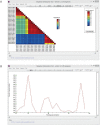SDT: a virus classification tool based on pairwise sequence alignment and identity calculation
- PMID: 25259891
- PMCID: PMC4178126
- DOI: 10.1371/journal.pone.0108277
SDT: a virus classification tool based on pairwise sequence alignment and identity calculation
Abstract
The perpetually increasing rate at which viral full-genome sequences are being determined is creating a pressing demand for computational tools that will aid the objective classification of these genome sequences. Taxonomic classification approaches that are based on pairwise genetic identity measures are potentially highly automatable and are progressively gaining favour with the International Committee on Taxonomy of Viruses (ICTV). There are, however, various issues with the calculation of such measures that could potentially undermine the accuracy and consistency with which they can be applied to virus classification. Firstly, pairwise sequence identities computed based on multiple sequence alignments rather than on multiple independent pairwise alignments can lead to the deflation of identity scores with increasing dataset sizes. Also, when gap-characters need to be introduced during sequence alignments to account for insertions and deletions, methodological variations in the way that these characters are introduced and handled during pairwise genetic identity calculations can cause high degrees of inconsistency in the way that different methods classify the same sets of sequences. Here we present Sequence Demarcation Tool (SDT), a free user-friendly computer program that aims to provide a robust and highly reproducible means of objectively using pairwise genetic identity calculations to classify any set of nucleotide or amino acid sequences. SDT can produce publication quality pairwise identity plots and colour-coded distance matrices to further aid the classification of sequences according to ICTV approved taxonomic demarcation criteria. Besides a graphical interface version of the program for Windows computers, command-line versions of the program are available for a variety of different operating systems (including a parallel version for cluster computing platforms).
Conflict of interest statement
Figures


References
-
- Kim M, Oh H-S, Park S-C, Chun J (2014) Towards a taxonomic coherence between average nucleotide identity and 16 S rRNA gene sequence similarity for species demarcation of prokaryotes. Int J Syst Evol Microbiol 64: 346–351. - PubMed
-
- Muhire B, Martin DP, Brown JK, Navas-Castillo J, Moriones E, et al. (2013) A genome-wide pairwise-identity-based proposal for the classification of viruses in the genus Mastrevirus (family Geminiviridae). Arch Virol 158: 1411–1424. - PubMed
-
- Larkin MA, Blackshields G, Brown NP, Chenna R, McGettigan PA, et al. (2007) Clustal W and Clustal X version 2.0. Bioinformatics 23: 2947–2948. - PubMed
Publication types
MeSH terms
LinkOut - more resources
Full Text Sources
Other Literature Sources
Miscellaneous

